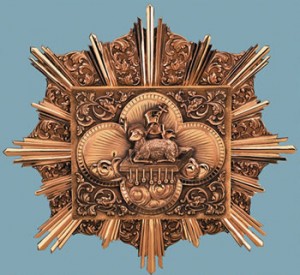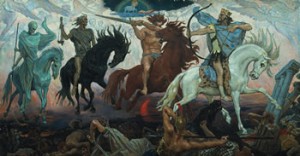The Book of Revelation (3)
REVELATION 4 – 6
We enter a new section of the book of Revelation. In chapters 4 and 5 we are given images of the sheer grandeur and majesty of God and his heavenly court. The centre of the entire creation is God, the source and goal of all things.
Remember the letter to Laodicea. Jesus was waiting at the door, asking to be admitted. Now Jesus shows John an open door, a door to heaven, and bids him, “Come up here.” Some more fundamentalist commentators try to make this the great divide in Revelation – everything up to this point has to do with the historical Church, everything from this point on has to do with the future. There is no warrant in the text for this.
At the centre of the universe is a throne on which is seated the One who is the centre of the universe. Note that it is not the Roman emperor who sits on this throne, but God himself. Observe that this new section of Revelation begins with God and the worship of God. John uses magnificent imagery, much of it borrowed from Ezekiel 1 and Isaiah 6.
Around the throne of God are twenty-four elders, each wearing a golden crown. These elders are royalty, yet when the praise of God is sung, the elders cast down their crowns and fall down before the One who is seated on the throne. The traditional hymn, “Holy, Holy, Holy,” speaks of these beings “casting down their golden crowns, around the glassy sea.” The triple repetition of the adjective “holy” is a biblical way of rendering a superlative – “holiest.” We know that a similar act of reverence was given to the Roman emperor by visiting client kings. In Scripture, the sea is often a place of chaos. But here, in the divine throne room, the sea is glassy and still. Chaos is overcome. Also around the throne are four living creatures full of eyes. (God is all-knowing about his creation.) The four living creatures represent all creation, and all creation is involved in the worship of God. John uses vivid imagery to stretch our imaginations to see the grandeur of God. He looks like jasper and carnelian! Around his throne is a rainbow that looks like an emerald!
Chapter 5 continues the scene of the throne room. In the hand of the One seated on the throne is a scroll sealed with seven seals. John becomes upset when it becomes obvious that no one is available who is worthy to open the seals and the scroll. John reminds us here that we are powerless to save ourselves. One of the elders tells John that the Lion of the tribe of Judah, the Root of David (titles of the Messiah) has conquered and can open the sealed scroll. John has been promised a Lion, but a Lamb appears instead. John hears about a lion but he sees a Lamb, and quite a spectacular Lamb it is – standing as if it had been slaughtered, having seven horns (all-powerful) and seven eyes (all-knowing). The Lamb is Jesus, who has died and by dying has conquered sin and death. All the Old Testament hopes and aspirations for the Lion are now revealed in the slaughtered but living Lamb. This Lamb conquers by dying for his enemies! Note that the Lamb does not replace God, but joins him on his throne. God works out his plan for the world specifically through the Lamb.
And now we come to the first series of disasters, for which the book of Revelation is unfortunately known. (The main point of Revelation is that creation belongs to God, its Creator. God continually calls all creation back to his plan and purpose. John uses standard apocalyptic imagery from the Old Testament to convey his message. But always, the punishments are sent to bring people to belief and obedience.) In chapters 6:1 through 8:2, the Lamb opens each of the seven seals on the scroll. The first four visions are the so-called Four Horsemen of the Apocalypse. These are followed by two other visions, then an interlude, and finally the last vision of the septet.
The four horsemen are reminiscent of images of coloured horses in the book of Zechariah. But John’s first audience would have recognised the symbols right away.
The horseman on the white horse had a bow, wore a crown and “came out conquering and to conquer.” This mounted archer would immediately bring to mind the Parthians, enemies lurking on the eastern boundary of the Roman Empire. Rome proved unable to subdue them, so how safe were the residents of Asia Minor?
The second rider mounts a bright red horse and wields a great sword. The horseman takes peace from the earth and makes us worry about violence within our communities instead of without.
The third seal is broken and there comes forth a rider on a black horse with a pair of scales in his hand. A voice from the midst of the four living creatures says, “A quart of wheat for a day’s pay, and three quarts of barley for a day’s pay, but do not damage the olive oil and the wine.” The poor will find it hard to feed their families, but the rich will continue to live comfortably.
The fourth rider is astride a pale (some translations say “sickly”) green horse. The rider’s name is Death. We are reminded of our own mortality, which none of us can escape.
The fifth seal is a warning of persecution. Remember that more Christians died for the Faith in the twentieth century than any other. The twenty-first is shaping up in similar fashion. God alone can provide real security. The sixth seal includes a great earthquake – Asia Minor was and is familiar with quakes – and other cosmic signs. Isaiah 34, Joel 2 and Amos 8 provide background for this message of judgment. God is giving a word of warning to trust in him alone.
(We will continue with chapter 7 and proceed to chapters 8-11 in next month’s issue.)



 Entries(RSS)
Entries(RSS)